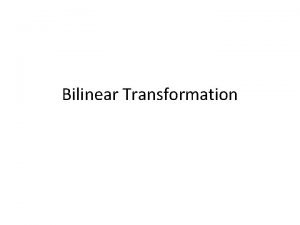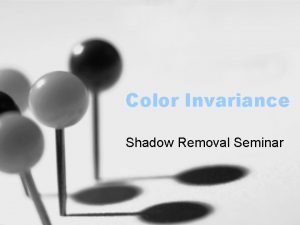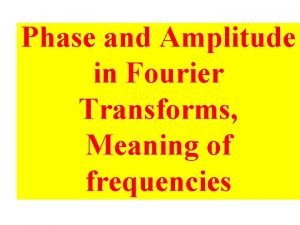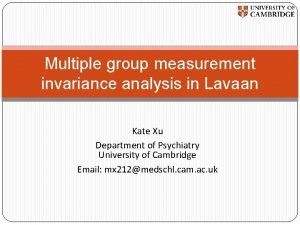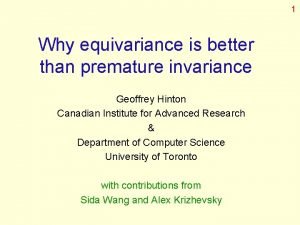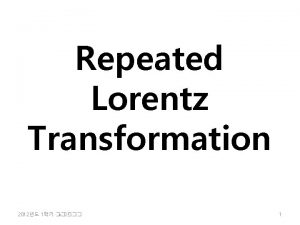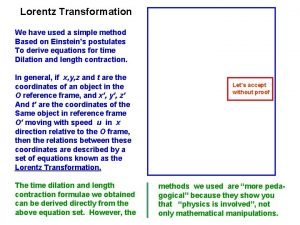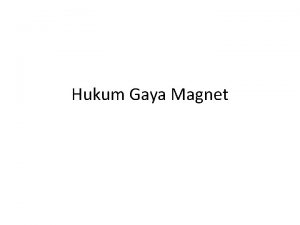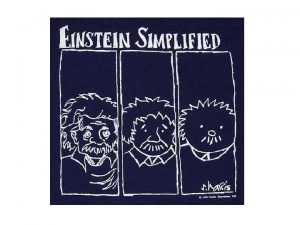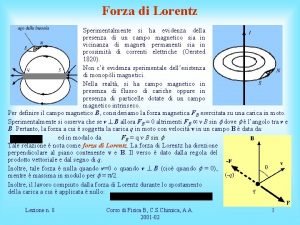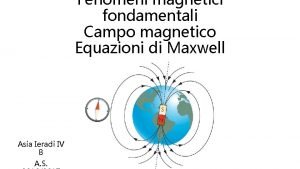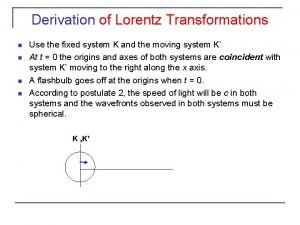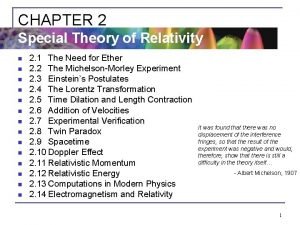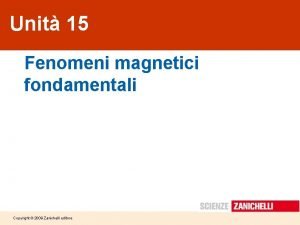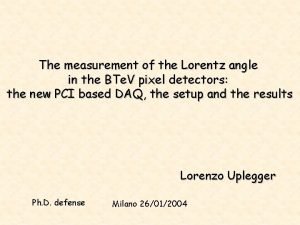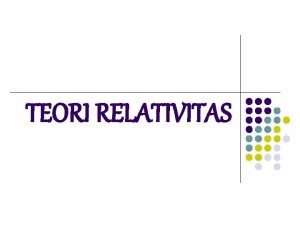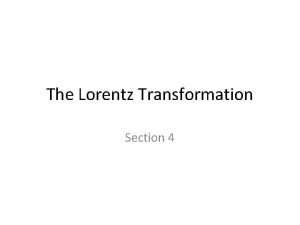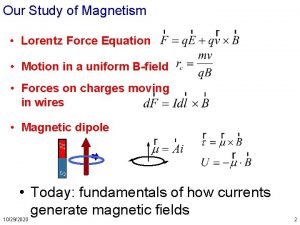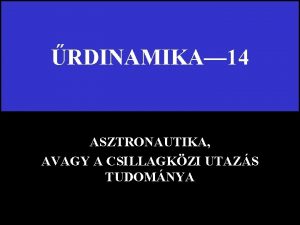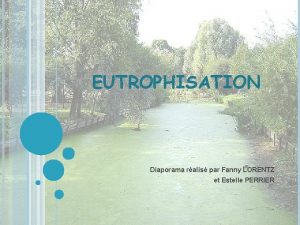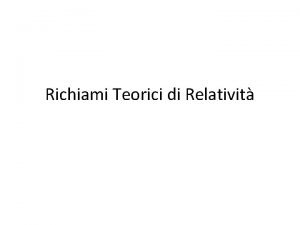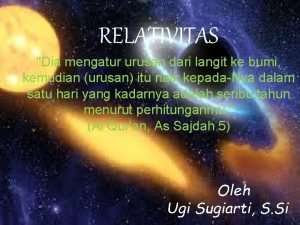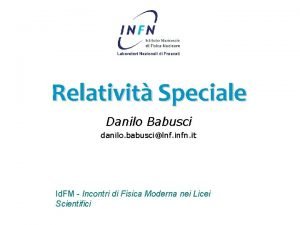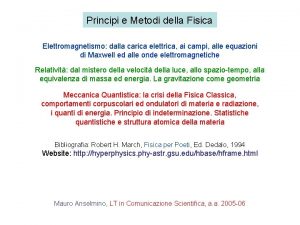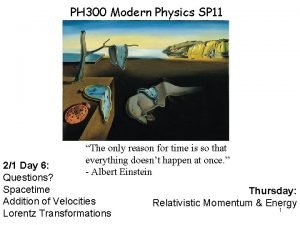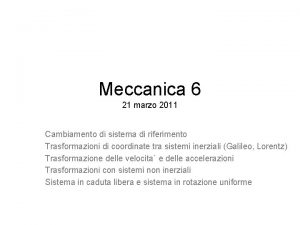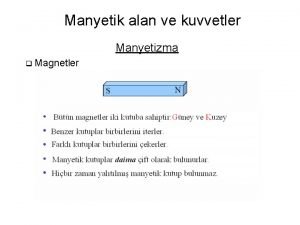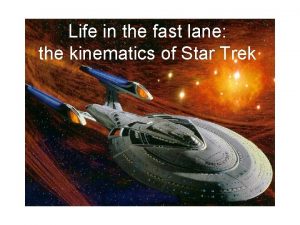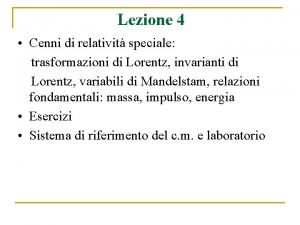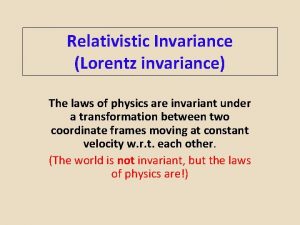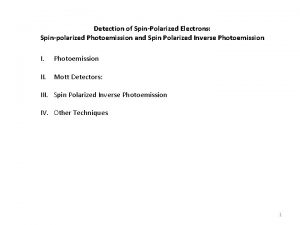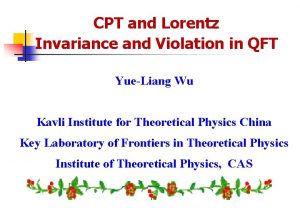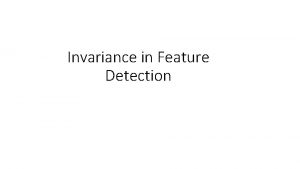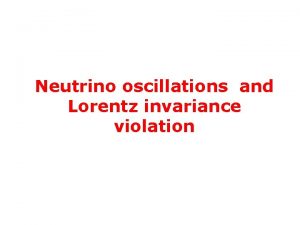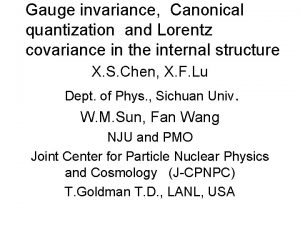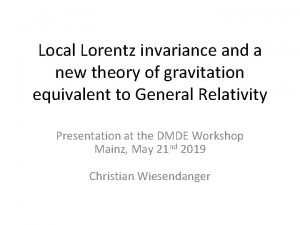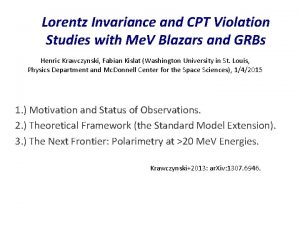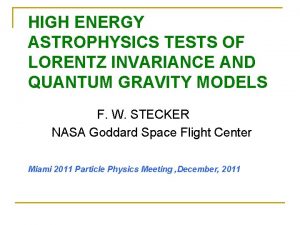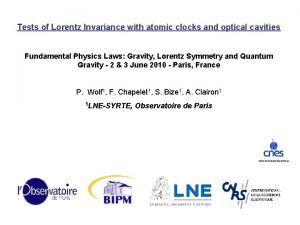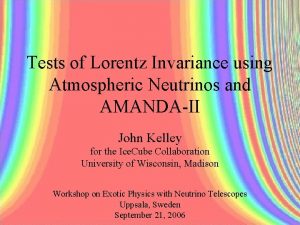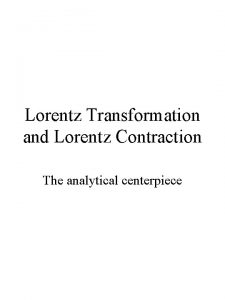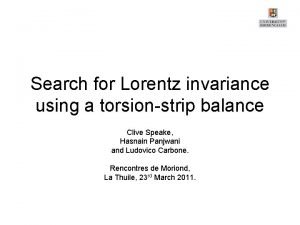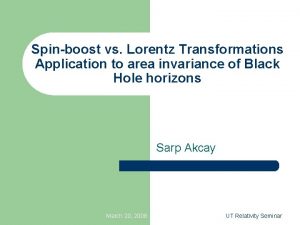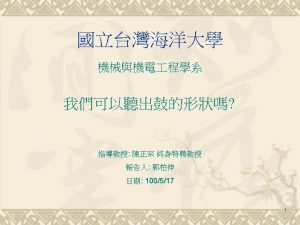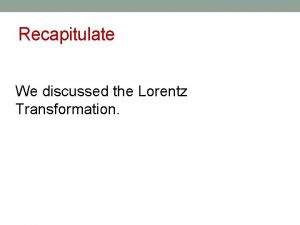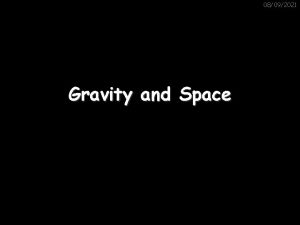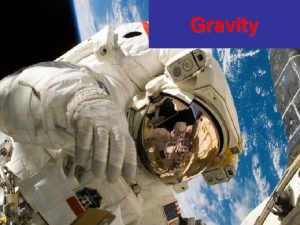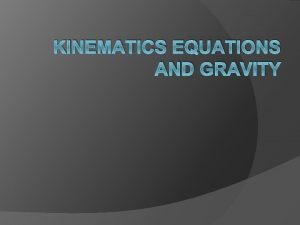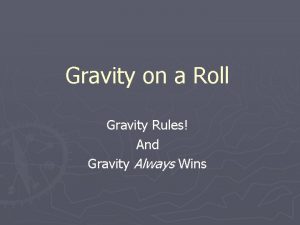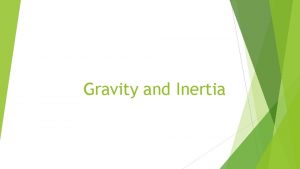Testing Lorentz Invariance and Gravity with a SpinPolarized

















































- Slides: 49

Testing Lorentz Invariance and Gravity with a Spin-Polarized Torsion Balance William Terrano CENPA, University of Washington

Outline • A Brief History of Eot-Wash (in pictures) • Description of a Spin-Polarized Pendulum (Blayne Heckel, Ted Cook, Claire Cramer, Eric Adelberger, Stefan Schlamminger, *** and myself) • Searches for CPT and Lorentz Violation (Alan Kostelecky, Neil Russel , Jay Tasson) • Lorentz Preserving Quantum Gravity (Yuri Bonder, Daniel Sudarsky) • Torsion Gravity (Cartan/Lost to History; Richard Hammond; Arcos & Pereira) • Tie things up

Experimental Concept

Experimental Concept

First Experimental Concept

First Experimental Concept

First Experimental Concept

First Experimental Concept

First Experimental Concept

Second Experimental Concept

Experimental Concept

Experimental Concept

What Does an Arrow Look Like? B inside = 9. 6± 0. 2 k. G B outside ≈ few m. G

What Does an Arrow Look Like? • • • 9. 8 x 1022 polarized electrons negligible mass asymmetry negligible composition asymmetry flux of B confined within octagons negligible external B field • Alnico: all B comes from electron spin: spins point opposite to B • Sm. Co 5: Sm 3+ ion has spin pointing along total B and its spin B field is nearly canceled by its orbital B field--so B of Sm. Co 5 comes almost entirely from the Co’s electron spins • therefore the spins of Alnico and Co cancel and pendulum’s net spin comes from the Sm and J = S

How to Make an Arrow? • Alnico • Sm. Co 5

How to Make an Arrow? • Alnico : (n) Ferromagnetic material made from a mix of ALuminum, NIckel and CObalt. Cast, it is a soft magnetic material that can be magnetized in house. Typical Magnetic Field Strengths of 1 Tesla, almost entirely due to aligned electron spin. • Sm. Co 5: (n)

How to Make an Arrow? • Alnico : (n) Ferromagnetic material made from a mix of ALuminum, NIckel and CObalt. Cast, it is a soft magnetic material that can be magnetized in house. Typical Magnetic Field Strengths of 1 Tesla, almost entirely due to aligned electron spin. • Sm. Co 5: (n)

How to Make an Arrow? • Alnico : (n) Ferromagnetic material made from a mix of ALuminum, NIckel and CObalt. Cast, it is a soft magnetic material that can be magnetized in house. Typical Magnetic Field Strengths of 1 Tesla, almost entirely due to aligned electron spin. • Sm. Co 5: (n) Rare-Earth magnet with unusually relevant exchange forces in the outer electron shell. Sintered, it is an extremely hard magnetic material that requires about 25, 000 Oersted to magnetize. It is machined in house, while fully magnetized. Typical Magnetic Field Strengths of 1 Tesla, half of which is due to orbital motion.

How to Make an Arrow? • Alnico : (n) Ferromagnetic material made from a mix of ALuminum, NIckel and CObalt. Cast, it is a soft magnetic material that can be magnetized in house. Typical Magnetic Field Strengths of 1 Tesla, almost entirely due to aligned electron spin. • Sm. Co 5: (n) Rare-Earth magnet with unusually relevant exchange forces in the outer electron shell. Sintered, it is an extremely hard magnetic material that requires about 25, 000 Oersted to magnetize. It is machined in house, while fully magnetized. Typical Magnetic Field Strengths of 1 Tesla, half of which is due to orbital motion.

How to Make an Arrow? We have Magnets, but we need Spins Half Way There!

How to Make an Arrow? We have Magnets, but we need Spins

How to Make an Arrow? We have Magnets, but we need Spins S N

How to Make an Arrow? We have Magnets, but we need Spins

How to Make an Arrow? We have Magnets, but we need Spins

How to Make an Arrow? We have Magnets, but we need Spins We have a complete Magnetic circuit!

How to Make an Arrow? We have Magnets, but we need Spins We have a complete Magnetic circuit!

How to Make an Arrow? We have Magnets, but we need Spins We have a complete Magnetic circuit!

How to Make an Arrow? We have Magnets, but we need Spins We have Neither!

How to Make an Arrow? We have Magnets, but we need Spins We have Both!

What Does an Arrow Look Like? • • • 9. 8 x 1022 polarized electrons negligible mass asymmetry negligible composition asymmetry flux of B confined within octagons negligible external B field • Alnico: all B comes from electron spin: spins point opposite to B • Sm. Co 5: Sm 3+ ion has spin pointing along total B and its spin B field is nearly canceled by its orbital B field--so B of Sm. Co 5 comes almost entirely from the Co’s electron spins • therefore the spins of Alnico and Co cancel and pendulum’s net spin comes from the Sm and J = S

What Does an Arrow Look Like? B inside = 9. 6± 0. 2 k. G B outside ≈ few m. G

What do you gain? • CPT/Lorentz Violation Constraints • Really probing plank scale physics • Full circle – 2 nd generation of theory AND experiment • Spin – Gyrocompass effect • An actual, DIRECT measurement that electron spin has angular momentum, it is not only a very useful analogy • Non-commutative geometry • Best limit on [xi, xj] • Torsion Gravity • Earliest(? ), and longest surviving(? ) modification of GR • Laboratory Test of Ultra High-Energy Symmetry breaking?

lab-fixed spin pendulum signal gyrocompass effect vertical band shows expected gyrocompass signal using Sm. Co 5 spin density determined from polarized n and γ scattering

The gyrocompass Our gyrocompass. Earth’s rotation Ω acting on J of pendulum produces a steady torque along suspension fiber Anschütz’s gyrocompass. Anschuetz-Kaempfe and Sperry separately patented gyrocompasses in UK and US. In 1915 Einstein ruled that Anschütz’s patent was valid. | Ω × J · n | where n is unit vector along local vertical. Because S= J this is equivalent to βN = 1. 616 × 10 -20 e. V

cosmic preferred frames? We all were taught that there are no preferred frames. But the Universe defines a frame in which the CMB is essentially isotropic. Could there be other preferred frame effects defined by the Universe? Kostelecky et al. developed a scenario where vector and axial-vector fields were spontaneously generated in the early universe and then inflated to enormous extents; particles couple to these preferred-frame fields in Lorentz -invariant manners. This “Standard Model Extension” predicts many new observables some of which violate CPT. One observable is E = σe· b e where b e is fixed in inertial space - its benchmark value is me 2/ MPlanck ≈ 2 × 10 -17 e. V

Lorentz-symmetry violating rotation parameters our work Cane et al, PRL 93(2004) 230801 Phillips et al, PRD 63(2001) 111101

non-commutative space-time geometry string theorists have suggested that the space-time coordinates may not commute, i. e. that where Θij has units of area and represents the mimimum observable patch of area, just as the commutator of x and px represents the minimum observable product of Δx Δpx “Review of the Phenomenology of Noncommutative Geometry” I. Hinchliffe, N Kersting and Y. L. Ma hep-ph/0205040

effect of non-commutative geometry on a spin non-commutative geometry is equivalent to a “pseudo-magnetic” field and thus couples to spins B Anisimov, Dine, Banks and Graesser Phys Rev D 65, 085032 (2002) L is a cutoff assumed to be 1 Te. V A

a condensed-matter byproduct of this work precise measurement of the spin density in Sm Co 5 magnetized to 9. 6 k. G recall that neutron and photon scattering experiments gave results that differed by about a factor or two

Wrap-up • These experiments are not just an eighteenth century technique cleverly re-applied to a 21 st c. problem. • They are a reflection of an eighteenth century manner of doing science • The basic questions we are all interested in are not so different from those of earlier times, either

Thanks Eric Adelberger and Blayne Heckel Eot-Wash Group To all the Listeners for Listening Aux Organizateurs pour Organizer To the cooks for cooking 9/29/2020 41

Experimental Concept

END

effect of non-commutative geometry on a spin non-commutative geometry is equivalent to a “pseudo-magnetic” field and thus couples to spins Anisimov, Dine, Banks and Graesser Phys Rev D 65, 085032 (2002) L is a cutoff assumed to be 1 Te. V B A

measuring the stray magnetic field of the spin pendulum B inside = 9. 6± 0. 2 k. G B outside ≈ few m. G

lab-fixed spin pendulum signal gyrocompass effect vertical band shows expected gyrocompass signal using Sm. Co 5 spin density determined from polarized n and γ scattering

Lorentz-symmetry violating rotation parameters our work Cane et al, PRL 93(2004) 230801 Phillips et al, PRD 63(2001) 111101

the Eöt-Wash rotating torsion balance vacuum can prehanger fiber HH coils autocollimator compensation masses thermal shield magnetic shielding pendulum feet turntable

data taking sequence 1 We reverse the dipole orientation within the rotating apparatus every day Plots show the measured twist. It is dominated by effects of the turntable (offset + slow drifts). By taking the difference between successive points, we isolate the EP signal.
 Impulse invariance transformation
Impulse invariance transformation Gravity for dummies and dummies for gravity equations
Gravity for dummies and dummies for gravity equations Invariance property
Invariance property Fourier transform amplitude and phase
Fourier transform amplitude and phase Lavaan measurement invariance
Lavaan measurement invariance Equivariance
Equivariance Positive testing vs negative testing
Positive testing vs negative testing Cs3250
Cs3250 Domain testing in software testing
Domain testing in software testing Kv charts in software testing
Kv charts in software testing Data flow testing strategies in software testing
Data flow testing strategies in software testing Anuj magazine
Anuj magazine Functional testing vs unit testing
Functional testing vs unit testing Language testing
Language testing Control structure testing in software engineering
Control structure testing in software engineering Decision table testing in software testing
Decision table testing in software testing Decision table technique
Decision table technique Pengertian black box testing
Pengertian black box testing Behavior testing adalah
Behavior testing adalah Extended decision table
Extended decision table Rigorous testing in software testing
Rigorous testing in software testing Testing blindness in software testing
Testing blindness in software testing Component testing is a black box testing
Component testing is a black box testing Software domain examples
Software domain examples Lorentz transformation matrix
Lorentz transformation matrix Psk lorentz
Psk lorentz Lorentz factor
Lorentz factor Hukum ohm
Hukum ohm Lorentz transformation equation derivation
Lorentz transformation equation derivation Rumus gaya magnetik
Rumus gaya magnetik Unità di misura forza di lorentz
Unità di misura forza di lorentz Fenomeni magnetici fondamentali
Fenomeni magnetici fondamentali Lorentz transformation equation derivation
Lorentz transformation equation derivation Lorentz transformation equation
Lorentz transformation equation Campo magnetico entrante e uscente
Campo magnetico entrante e uscente Lorentz angle
Lorentz angle Contoh soal transformasi galileo dan transformasi lorentz
Contoh soal transformasi galileo dan transformasi lorentz Lorentz
Lorentz Unit of electric field
Unit of electric field Lorentz transzformáció
Lorentz transzformáció Fanny lorentz
Fanny lorentz Trasformazione di lorentz
Trasformazione di lorentz Kontraksi lorentz
Kontraksi lorentz Intervallo invariante
Intervallo invariante Onde trasversali
Onde trasversali What i sp
What i sp Equazione di lorentz
Equazione di lorentz Manyetik kuvvet
Manyetik kuvvet Fastlane spaceship
Fastlane spaceship Trasformazioni lorentz
Trasformazioni lorentz
